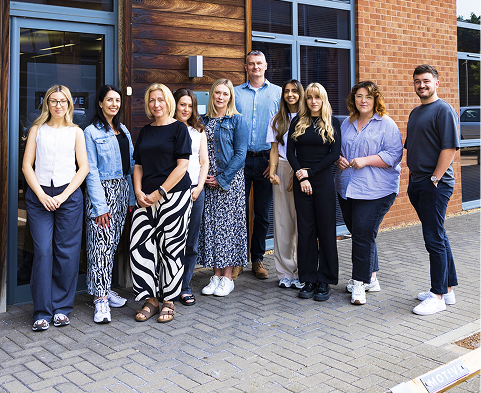Showcasing customer success stories and real-life experiences is incredibly valuable in PR and marketing. Not only will it humanise your brand and make you more relatable, but customer stories also add trust and credibility - one of the most valuable currencies in the industry.
Customer stories are commonly used by PR and marketing professionals to showcase how using a brand’s products or service has made a genuine and tangible difference in real people’s lives. Instead of making generic claims of how your brand can positively impact customers, case studies provide compelling narratives, real life experiences and strong quotes from your customers.
Good customer testimonials have a significant impact on consumers’ purchasing decisions. Research shows that 84% of consumers trust reviews from other customers more than industry experts (67%) or companies and brands (41%). This is why it’s important to utilise authentic customer stories in your communications strategy, as they help bridge the gap between marketing promises and real-world outcomes.
.jpg)
From a PR perspective, you can turn positive customer stories into case studies. From showcasing health and fitness transformations to highlighting how your product has helped budget-conscious families save money, these real-life narratives create great human interest stories that can land excellent media coverage.
Case studies don’t happen overnight. There’s a lot of time and effort that goes into setting them up, waiting for the results, interviewing the individuals and then outreaching in order to gain the coverage, but the end result pays off.
In this blog, we’ll explore why customer stories are so effective, what makes a strong case study, how to identify and build one, and highlight examples of successful case studies that have helped brands boost visibility and build trust.
What’s in this article:
- What is a case study?
- Why do customer stories work in PR and marketing strategies?
- How do you find a good case study?
- How to create a successful case study for PR
- Examples of successful case studies
- Key takeaways
What is a case study?
To sum it up, a case study is a detailed story about how a real customer used your product or service, found value in it and achieved meaningful results or reached a specific goal. To be truly effective, a case study should have a strong story at its core. There needs to be something interesting, unusual or remarkable about the experience to capture attention.
An emotional hook can often help your case study stand out. It’s not just about the results, but it’s about the person behind the story. Maybe they overcame a personal struggle, took a big risk or achieved something they didn’t think was possible, and your brand played a meaningful role in that journey. It also helps if the story features a recognisable person. Familiar names add weight and can attract more media interest, even if the story itself is relatively simple.
A case study should tell the full story, from the moment your customer was facing a challenge, through their decision to try your product or service and into the results they achieved.
Why do customer stories work in PR and marketing strategies?
A simple answer to this question is that people are tired of being sold to. There are so many brands out there constantly advertising their products and services, so it’s hard to know who to trust anymore. What really stands out to customers is something genuine. Hearing about people’s real-life experiences with a brand and seeing how they got results is instantly more trustworthy, and it makes potential customers think: “If it worked for them, maybe it’ll work for me too”.
This is why in PR, customer stories are so powerful. Journalists love a human angle as they’re more relatable, rather than a generic product announcement from a brand. A well-told customer story brings a real voice into the mix as it showcases someone who’s faced a challenge, found a solution and seen tangible results. That kind of narrative makes it easier for media outlets to create engaging stories that their audiences will care about.
One of the best things about using customer stories in your PR and marketing strategy is that they don’t feel like obvious brand promotion. Instead of shouting “you should buy our product,” you’re letting your customers do the talking. This approach feels more authentic and gives your audience space to form their own opinions, without the pressure of a hard pitch which can be off-putting to consumers.
Research revealed that 71% of consumers are deterred by intrusive brand promotion, making them less likely to purchase. So instead of bombarding people with polished ads that try to push them to buy your product or service, you’ll often have more success by sharing authentic customer stories that offer a refreshing alternative and resonate with your target audience.
.jpg)
How do you find a good case study?
One of the easiest approaches to finding a good case study is to think about some of your most vocal customers who have shouted about your product or service on social media or who have left glowing reviews. These customers are often the people most willing to share their experiences in more detail.
If you’ve got a specific person in mind for a case study, like a recognisable face or influencer, it can be worth offering them your product or service to try, in exchange for sharing their honest experience. If they have a positive experience, you may be able to collaborate to create a case study from the ground up. Make sure to give them enough time to really put the product to the test, so their feedback feels genuine and thorough.
Another effective way to find great case studies is to take a proactive approach by doing some research and coming up with case study prompts. You could put these ideas forward to your customers, for example by creating a post on your social media that invites them to share their stories. By opening up this kind of conversation, you may end up gathering a pool of authentic stories that you can use in your PR and marketing strategies. It may be worth giving the customers an initiative, like free products or services for a set period of time to encourage participation and motivate them to share their experiences.
Another thing to keep in mind is to look for case studies that fit with your target publications. For example, if you’re targeting women’s titles with a case study and the key demographic is women aged 35+, then that’s who you want to find as your case study.
You’ll also want to produce case studies that are relevant to the here and now, and journalists will want the same thing. For this reason, it’s best to use customer stories from the last 6-12 months, but the more recent, the better.
How to create a successful case study for PR
Building a solid case study takes quite a bit of time and planning, but it’s definitely worth the effort. Here’s a simple step-by-step guide to help you create a strong case study:
Identify the right customer for your case study
Think about who are your most vocal and enthusiastic customers, as they’re the easiest to approach because they’re already excited about your brand. Or alternatively, invite customers to share their stories via social media. If you have a specific influencer or recognisable person in mind, you can consider offering them your product to try in exchange for them sharing their story. Just make sure the customer fits your target publication’s demographic and that their story is recent and relevant.
.jpg)
Reach out and brief them
Contact the chosen customer to explain the case study process. Outline what you’ll need from them and tell them the publications their story might be published in. Where possible, it’s helpful to share some examples of similar coverage, so they’ve got a better idea of what it will look like. Make sure to get their written approval that confirms they’re comfortable with how their story and images will be used.
Conduct an interview
We always recommend conducting the interview over the phone, via video call or in person. Speaking directly allows you to build rapport and dig deeper into the emotional elements of their story, as people tend to open up more in conversation compared to sending their answers over email. This will help you uncover the really powerful quotes that bring the story to life.
Gather results
Strong results are what give your case study credibility, so it’s important to ask your customer for any evidence that backs up their experience. This could be statistics, before-and-after photos, timelines or anything that shows real, measurable impact.
Get images
Good pictures can make or break a case study. They don’t need to be professionally shot - three or four pictures which really tell the story, taken on a mobile phone is all you need.
Write the press release
Craft a clear and engaging press release based on the case study. Focus on the customer’s journey, the problem they faced, the solution your brand provided and the positive results achieved. Make the story authentic and relatable, and lead with the strongest angle, especially if it has emotional or surprising elements. If you’ve got a specific publication where you want to land coverage, you could also research how their journalists structure feature pieces and headlines, and tailor your tone and format to match their style.
Create a media list
Build a cohesive list of journalists and media contacts from your target publications. Look for writers who cover similar case studies, human interest features or your specific industry. The more tailored your list, the better your chances of landing meaningful coverage.
Pitch to your target publications
Reach out to your media contacts, highlighting the human interest angle and why the story would resonate with their readers. Make sure to personalise your pitch, include a strong subject line and make it easy for them to access all relevant images
Examples of successful case studies
Life-saving unicorn inhalers
Inhaler Tailor is a brand creating personalised and fun inhaler cases designed to help children feel more confident about using their inhalers in public.
What made this campaign so successful wasn’t just the product - it was the emotional story behind it.
We created the case study around Martha, a young girl with asthma who was initially embarrassed about her condition, but a unicorn-themed inhaler case helped change that, and that became the emotional hook for the campaign.
The story ran across major UK outlets, including a feature on BBC Breakfast, with additional coverage across regional news and lifestyle sites.

Money-saving families
We partnered with MuscleFood and created a number of case studies with savvy mums using the brand’s meat hampers to create affordable meals for their families. These case studies worked well because they focused on real people facing everyday challenges which many people can relate to.
By sharing authentic stories about how these mums stretched their budgets without sacrificing quality or taste, the case studies offered practical, inspiring solutions that resonated with a wide audience.
Celebrity health and fitness transformations
We also created some health and fitness transformation case studies for the MuscleFood brand.
One featured Love Island star Olivia Bowen who shared how she ditched her go-to fast food routine by switching to the brand’s healthy ready meals. In another case study, reality-TV star Amy Tapper from Gogglebox revealed how using MuscleFood’s meal solutions helped transform her body and mindset.
The case studies secured excellent coverage in women’s and lifestyle magazines because they included relatable transformation journeys, recognisable names, an emotional hook and showed tangible results.
Key takeaways
- Customer stories build trust. Incorporating them into your PR and marketing strategies humanises your brand and builds credibility through real, relatable experiences that resonate with your audience.
- Testimonials influence buying decisions. People are tired of being sold to - they’re far more likely to trust honest reviews from other customers than brand messaging alone.
- Case studies bring customer stories to life. In PR, this means showing how a real customer used your product or service, found value in it, and achieved a specific goal or result.
- Start with your happiest customers. One of the easiest ways to find a strong case study is to approach your most vocal and satisfied customers - they’re usually the most willing to share their experiences.
- Emotion and results make stories stand out. The best case studies feature a clear transformation, a challenge overcome, or an emotional journey that others can relate to.
- Great case studies take effort - but they’re worth it. From identifying the right person to interviewing, sourcing images and pitching to press, it takes time - but journalists love real, human-led stories, and a strong case study can secure excellent media coverage.
If you’re looking to incorporate case studies into your PR and marketing strategy, get in touch for a quick chat with our senior team.



.jpg)

.jpg)
.jpg)


.jpg)

